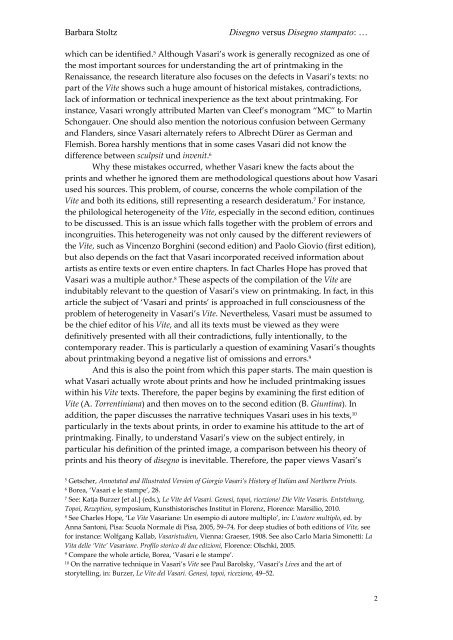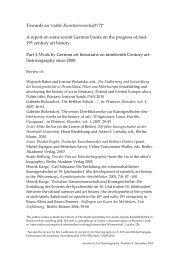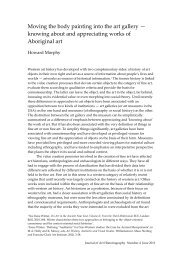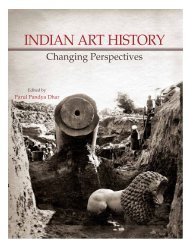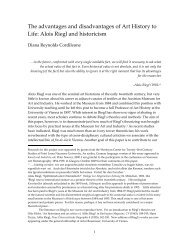7-BS/1 - Journal of Art Historiography
7-BS/1 - Journal of Art Historiography
7-BS/1 - Journal of Art Historiography
Create successful ePaper yourself
Turn your PDF publications into a flip-book with our unique Google optimized e-Paper software.
Barbara Stoltz Disegno versus Disegno stampato: …<br />
which can be identified. 5 Although Vasari’s work is generally recognized as one <strong>of</strong><br />
the most important sources for understanding the art <strong>of</strong> printmaking in the<br />
Renaissance, the research literature also focuses on the defects in Vasari’s texts: no<br />
part <strong>of</strong> the Vite shows such a huge amount <strong>of</strong> historical mistakes, contradictions,<br />
lack <strong>of</strong> information or technical inexperience as the text about printmaking. For<br />
instance, Vasari wrongly attributed Marten van Cleef’s monogram “MC” to Martin<br />
Schongauer. One should also mention the notorious confusion between Germany<br />
and Flanders, since Vasari alternately refers to Albrecht Dürer as German and<br />
Flemish. Borea harshly mentions that in some cases Vasari did not know the<br />
difference between sculpsit und invenit. 6<br />
Why these mistakes occurred, whether Vasari knew the facts about the<br />
prints and whether he ignored them are methodological questions about how Vasari<br />
used his sources. This problem, <strong>of</strong> course, concerns the whole compilation <strong>of</strong> the<br />
Vite and both its editions, still representing a research desideratum. 7 For instance,<br />
the philological heterogeneity <strong>of</strong> the Vite, especially in the second edition, continues<br />
to be discussed. This is an issue which falls together with the problem <strong>of</strong> errors and<br />
incongruities. This heterogeneity was not only caused by the different reviewers <strong>of</strong><br />
the Vite, such as Vincenzo Borghini (second edition) and Paolo Giovio (first edition),<br />
but also depends on the fact that Vasari incorporated received information about<br />
artists as entire texts or even entire chapters. In fact Charles Hope has proved that<br />
Vasari was a multiple author. 8 These aspects <strong>of</strong> the compilation <strong>of</strong> the Vite are<br />
indubitably relevant to the question <strong>of</strong> Vasari’s view on printmaking. In fact, in this<br />
article the subject <strong>of</strong> ‘Vasari and prints’ is approached in full consciousness <strong>of</strong> the<br />
problem <strong>of</strong> heterogeneity in Vasari’s Vite. Nevertheless, Vasari must be assumed to<br />
be the chief editor <strong>of</strong> his Vite, and all its texts must be viewed as they were<br />
definitively presented with all their contradictions, fully intentionally, to the<br />
contemporary reader. This is particularly a question <strong>of</strong> examining Vasari’s thoughts<br />
about printmaking beyond a negative list <strong>of</strong> omissions and errors. 9<br />
And this is also the point from which this paper starts. The main question is<br />
what Vasari actually wrote about prints and how he included printmaking issues<br />
within his Vite texts. Therefore, the paper begins by examining the first edition <strong>of</strong><br />
Vite (A. Torrentiniana) and then moves on to the second edition (B. Giuntina). In<br />
addition, the paper discusses the narrative techniques Vasari uses in his texts, 10<br />
particularly in the texts about prints, in order to examine his attitude to the art <strong>of</strong><br />
printmaking. Finally, to understand Vasari’s view on the subject entirely, in<br />
particular his definition <strong>of</strong> the printed image, a comparison between his theory <strong>of</strong><br />
prints and his theory <strong>of</strong> disegno is inevitable. Therefore, the paper views Vasari’s<br />
5 Getscher, Annotated and Illustrated Version <strong>of</strong> Giorgio Vasari’s History <strong>of</strong> Italian and Northern Prints.<br />
6 Borea, ‘Vasari e le stampe’, 28.<br />
7 See: Katja Burzer [et al.] (eds.), Le Vite del Vasari. Genesi, topoi, ricezione/ Die Vite Vasaris. Entstehung,<br />
Topoi, Rezeption, symposium, Kunsthistorisches Institut in Florenz, Florence: Marsilio, 2010.<br />
8 See Charles Hope, ‘Le Vite Vasariane: Un esempio di autore multiplo’, in: L’autore multiplo, ed. by<br />
Anna Santoni, Pisa: Scuola Normale di Pisa, 2005, 59–74. For deep studies <strong>of</strong> both editions <strong>of</strong> Vite, see<br />
for instance: Wolfgang Kallab, Vasaristudien, Vienna: Graeser, 1908. See also Carlo Maria Simonetti: La<br />
Vita delle ‘Vite’ Vasariane. Pr<strong>of</strong>ilo storico di due edizioni, Florence: Olschki, 2005.<br />
9 Compare the whole article, Borea, ‘Vasari e le stampe’.<br />
10 On the narrative technique in Vasari’s Vite see Paul Barolsky, ‘Vasari’s Lives and the art <strong>of</strong><br />
storytelling, in: Burzer, Le Vite del Vasari. Genesi, topoi, ricezione, 49–52.<br />
2


